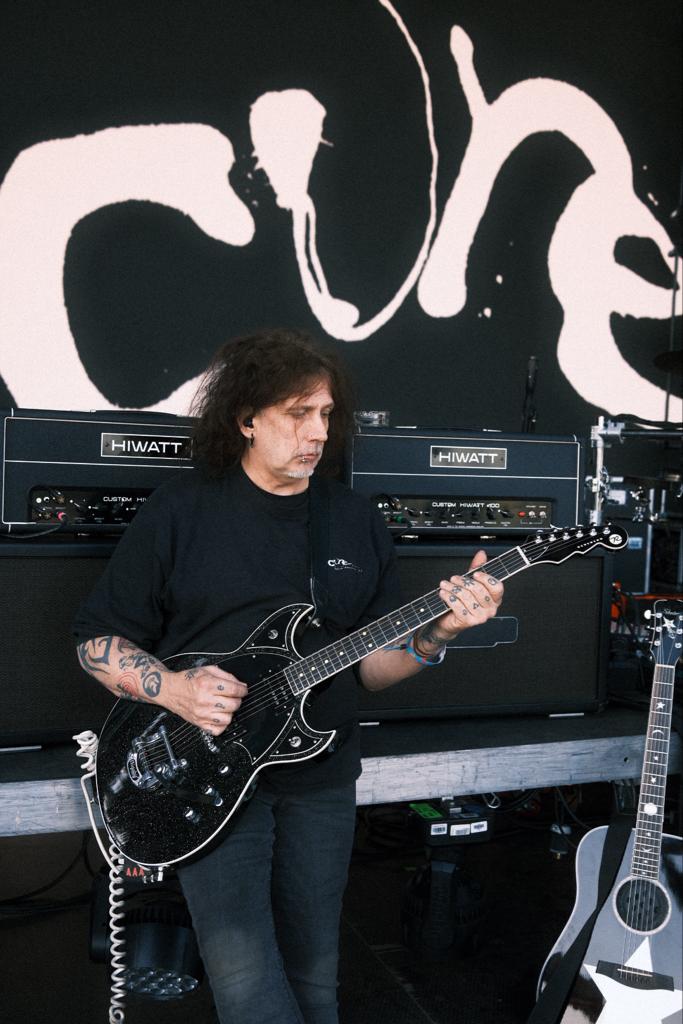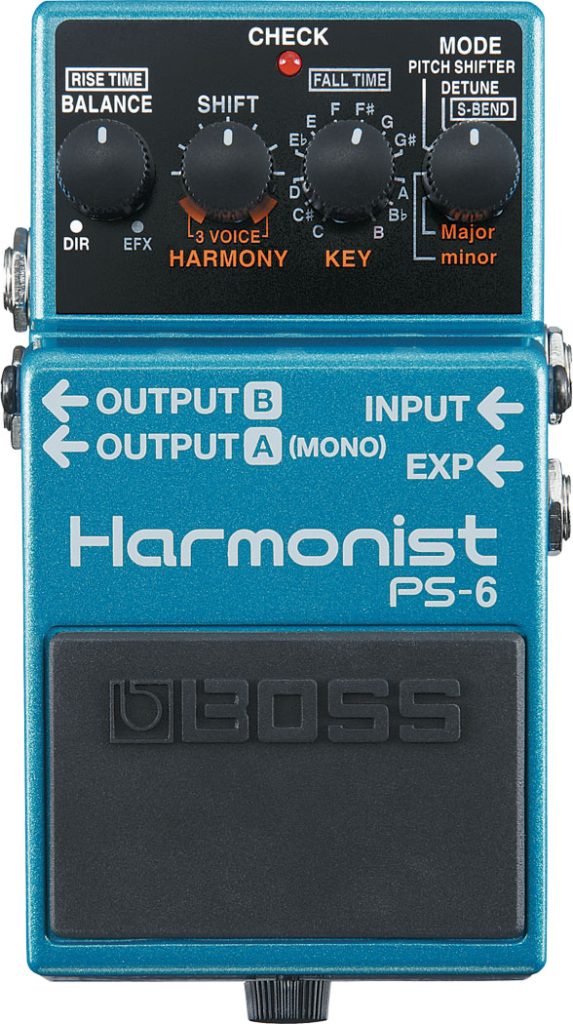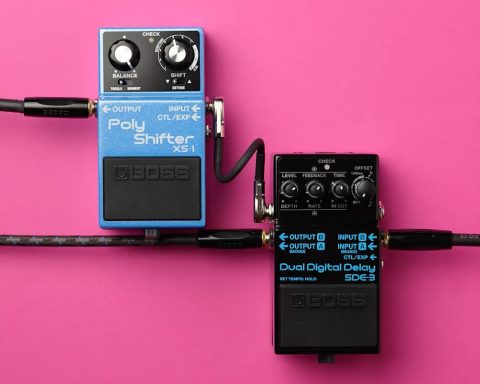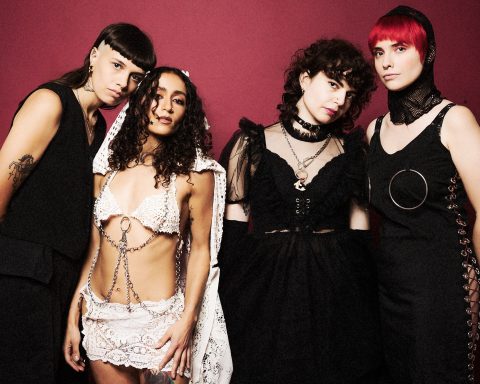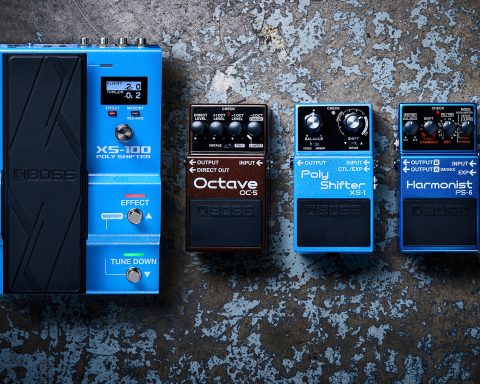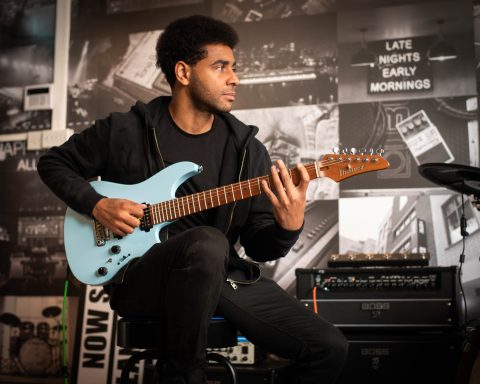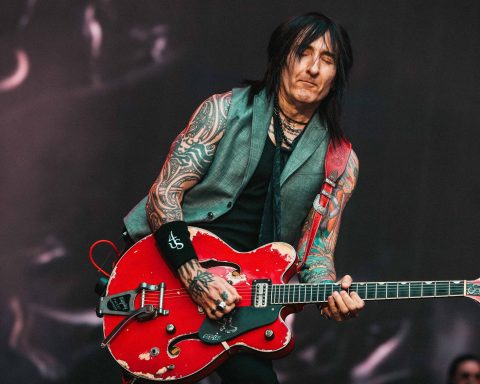Al Robinson’s expansive career as a guitar tech has seen him collaborate with a vast array of artists, from Sheryl Crow and Texas to The Jesus and Mary Chain and New York Dolls. For years, he has remained the trusted right-hand man to one of the guitar world’s finest: Reeves Gabrels. But few players have a rig—or an approach to gear—quite like Gabrels. This endlessly inventive virtuoso is a true connoisseur of guitar effects, as heard in his groundbreaking work with David Bowie, Tin Machine, and now The Cure. In this exclusive interview, Robinson takes us deep inside Gabrels’ expansive stompbox collection, explains why the guitarist is “the best tech you’ll ever meet,” and shares tales of BOSS tattoos. Oh, and one more thing—always respect the chain!
Folk-Rock Roots
How did you get into guitar tech work?
I started out working in a local crew in Newcastle—the legendary Wallace crew. One of the crew chiefs, Ant Fail, was a guitar tech for a couple of bands I loved, and I basically hassled him about wanting to do what he did. He eventually took me on tour with folk-rock veterans Oysterband to do merch.
After a couple of tours, he couldn’t fit their summer shows into his schedule and asked if I wanted to do backline for them for the summer. So, we set off for a weekend run together. At the first gig, I watched him work, asked questions, and took notes. At the second gig, I did it all while he watched me and told me what I’d done wrong. After that, I was on my own! It was one of the most stressful summers of my life and a very steep learning curve, but they were very patient with me, and I ended up being with them for around ten years.
"I first met Reeves Gabrels as he was bringing his own band to the UK and needed a Tour Manager."
Al Robinson
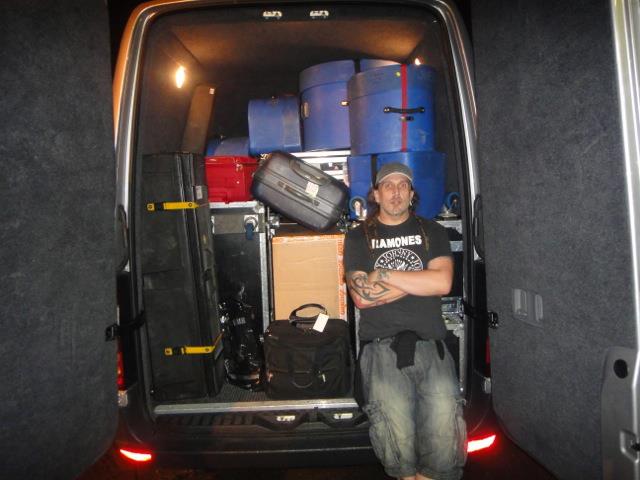
"I feel very lucky to have spent time with David Johansen and Sylvain Sylvain."
Al Robinson
From Proto-Punk to Post-Rock
Which artists did you work with after Oysterband?
As time went on, I started to pick up other gigs, such as 65daysofstatic and New York Dolls. 65daysofstatic was a whole new learning curve involving different tunings for every song and even catching a guitar that Joe would throw in one song in the set. New York Dolls was really an honor to do. I feel very lucky to have spent time with David Johansen and Sylvain Sylvain.
I moved from Newcastle to Brighton in 2003 and ended up with The Go! Team for quite a long time. I still do occasional work with them, although on my last tour, I moved from tech to driving the family bus with Ninja, Niadzi Muzira, and four little kids. That was possibly the most fun I’ve ever had on tour!
Also notable in that time were Palma Violets. I was with them from almost the beginning to almost the end. They were like my four little brothers, and we had some crazy adventures around the world together.
Finding The Cure
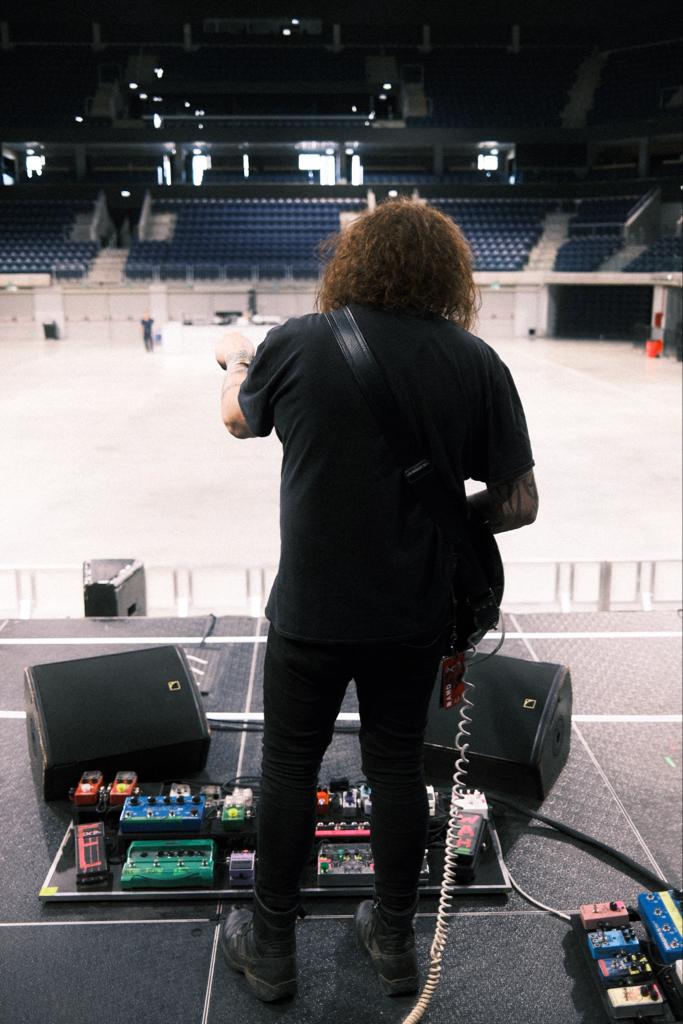
How did you meet Reeves Gabrels?
I first met Reeves Gabrels, who I now work for in The Cure, as he was bringing his own band to the UK and needed a Tour Manager. Our mutual friend Dan Baird of The Georgia Satellites put us in touch, and after about a week of knowing each other, we became great friends.
I lived in his house for most of the summer of 2016 while he was away with The Cure. At the time, I had such a tight schedule with The Subways that I was never able to get back to the south of France where I was living.
Which other artists besides The Cure have you worked with in recent years?
I’ve worked with quite a cross-section of artists in the last few years. They range from Uncle Acid & the Deadbeats and rock ‘n’ rollers Danko Jones to Sea Power and shoegaze legends The Jesus and Mary Chain. I’ve also worked with ’80s legends like Andy Taylor and Haircut 100 and ’90s heroes such as Sheryl Crow, Texas, and Cast. I also did a tour with Danish neo-classical pianist Agnes Obel, which didn’t involve guitars but did involve some of the most complex pedalboards I’ve ever worked with!
"Reeves has two pedalboards... The second, smaller board is for when Reeves is playing Fender Bass VI."
Al Robinson
A Forest of Pedals
Tell us about Reeves Gabrels’ The Cure rig.
Reeves has two pedalboards. His main board (which is huge and is a two-person lift) runs stereo into two custom-built Audio Kitchen heads. They’re hooked up to two Mesa Boogie 2×12 cabs via Palmer speaker simulator boxes and are connected with custom speaker cables hand-built by Gil Divine at Divine Noise Cables. We use the Palmers because there’s so much traffic on the stage that the mics kept getting knocked off the cabs.
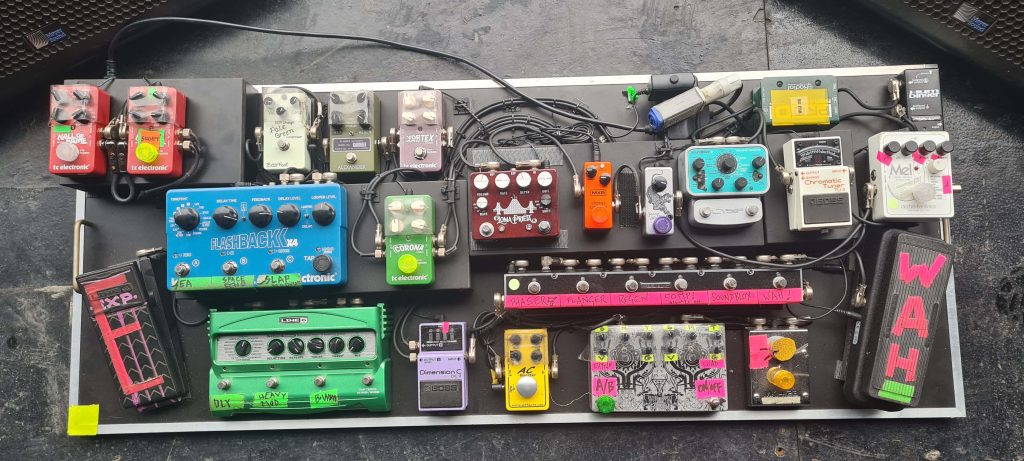
The second, smaller board is for when Reeves is playing Fender Bass VI. It sits at a right angle to the main board and runs mono into a Hiwatt Custom 100 head and another Mesa Boogie 2×12, again via a Palmer speaker simulator. All our cabling is hand-made to order, either from Divine Noise or Rattlesnake.
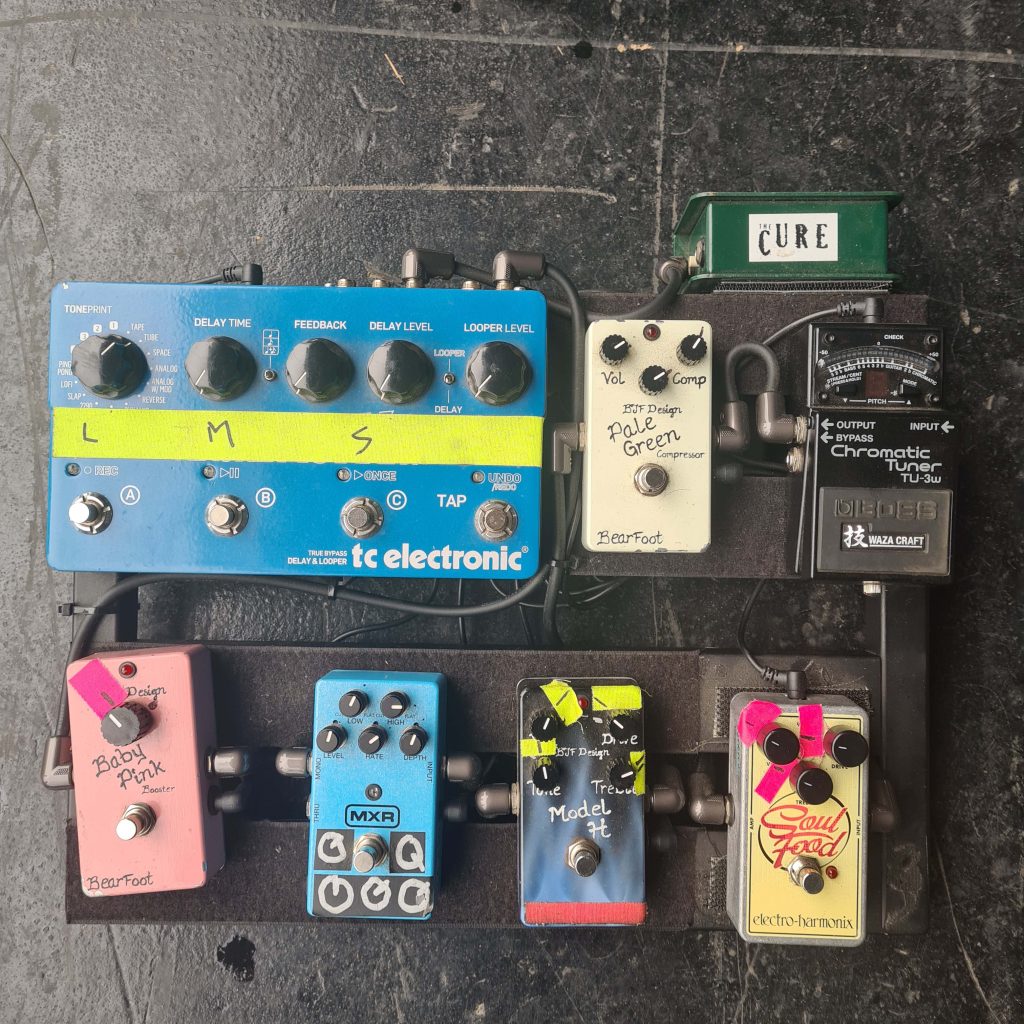
"There’s also an '80s vintage DC-2 Dimension C set to Mode 3. It’s pretty much always on and is integral to Reeves’ signature sound."
Al Robinson
Which BOSS pedals feature on Reeves Gabrels’ The Cure pedalboards?
Of course, the main board uses a TU-3 Chromatic Tuner at the top of the chain. There’s also an ’80s vintage DC-2 Dimension C set to Mode 3. It’s pretty much always on and is integral to Reeves’ signature sound. When we’re on tour, if we come across an ’80s DC-2 we generally snap them up as it features on most pedalboards Reeves puts together.
During the lockdown, I rebuilt the Bass VI board, and we went with the Waza Craft TU-3W Chromatic Tuner. Reeves and I like it better than the TU-3 because it’s “none more black.” I also find the blue LEDs easier to see under glare.
I absolutely love using the BOSS TU-3 Chromatic Tuner app on my phone. I’ve tried a ton of app tuners, and this is the one I always come back to. It looks so cool! My girlfriend is a tattoo artist, and I’ve been toying with the idea of getting a tattoo of a TU-3 and crossed string winders for a while now—like a guitar tech version of a skull and crossbones.
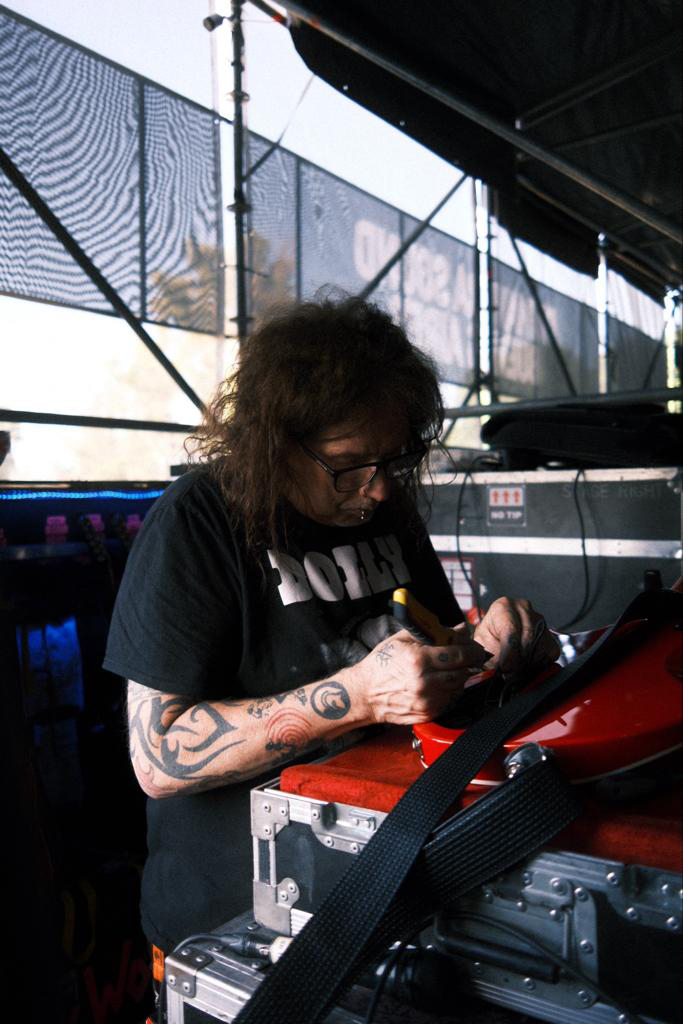
"The GE-7 Equalizer is one of Reeves Gabrels' favorite go-to pedals."
Al Robinson
BOSS Selector
Which BOSS pedals does Reeves Gabrels use for his own projects?
On Reeves’ pedalboards for his own projects, there’s usually a DC-2, the obligatory TU-3, and often an LS-2 Line Selector. He has a couple of modded GE-7 Equalizers that he uses as boosts on a lot of projects. He said the GE-7 is one of his favorite go-to pedals.
The CS-3 Compression Sustainer is a regular sight at the compression stage. Working with Reeves is great because he’s basically the best tech you’ll ever meet. He’ll almost certainly have the answer if there’s something foxing you!
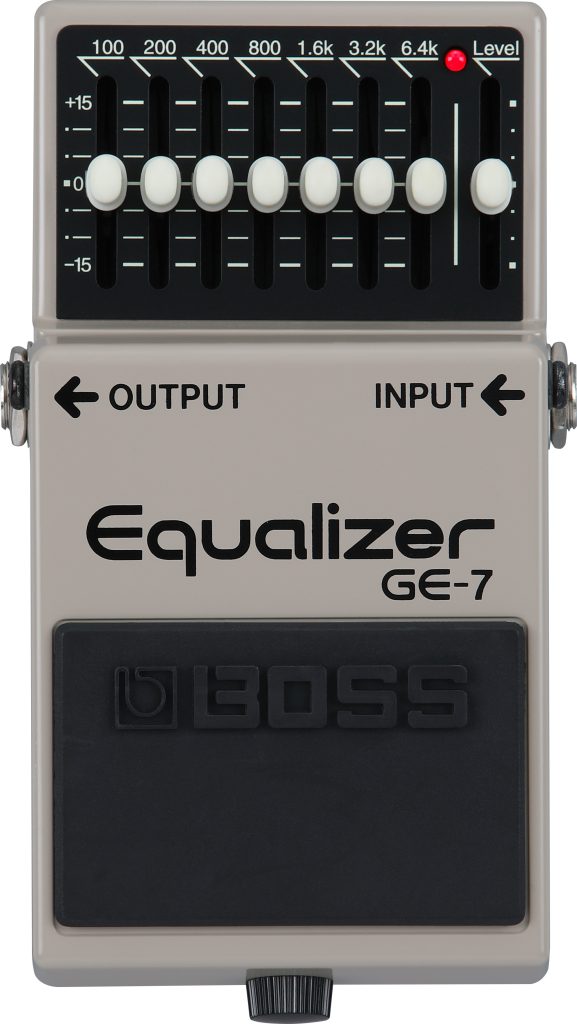
How does Reeves Gabrels use BOSS gear in the studio?
Early last year, we consolidated everything Reeves had in storage in the UK and Nashville into his home studio unit in Upstate New York. One of my jobs was to catalog everything. It was a fun project, and Reeves rediscovered a bunch of stuff from his Bowie days that he hadn’t used in years, such as his DD-5 Digital Delay, SD-2 Dual Overdrive, PH-2 Super Phaser, and PS-5 Super Shifter—all covered in his own custom paint jobs.
"Reeves also has four '80s RPS-10 Digital Pitch Shifter/Delay units from the BOSS Micro Rack Series that he used all the time with Bowie."
Al Robinson
Then there are a couple of BF-2 Flangers, multiple NS-2 Noise Suppressors, and a PS-6 Harmonist, which is a lovely bit of kit. There’s an HM-2 Heavy Metal, an SD-1 Super Overdrive, and a DF-2 Super Feedbacker & Distortion for all your distortion needs. He’s also got at least one of each of the Digital Delay compact pedal series!
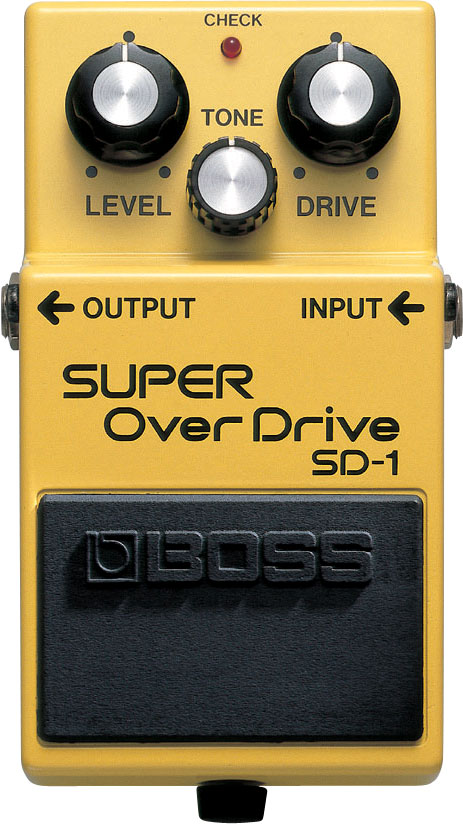
What does Reeves Gabrels like about BOSS pedals?
In his own words: “BOSS pedals sound great, and they don’t break. But if they did, you could replace them anywhere in the world.”
“BOSS pedals sound great, and they don't break. But if they did, you could replace them anywhere in the world.”
Reeves Gabrels
How do some of the other guitarists you’ve worked with use their BOSS pedals?
Tony McGovern from Texas uses the FRV-1 Fender Reverb, CH-1 Super Chorus, and SD-2 Dual Overdrive on his board. The FRV-1 is a great-sounding reverb and perfect for those Northern soul vibes they have. The SD-2 is a classic that is wonderfully versatile; it can cover all the bases for your distortion needs.
William Reid from The Jesus and Mary Chain uses his board for four gradually rising levels of distortion, the last two of which are provided by a GE-7 and then an OD-3 Overdrive. All the stages are run through an ES-5 Effects Switching System for control/bypass. He also uses an RC-300 Loop Station to control all his feedback loops.
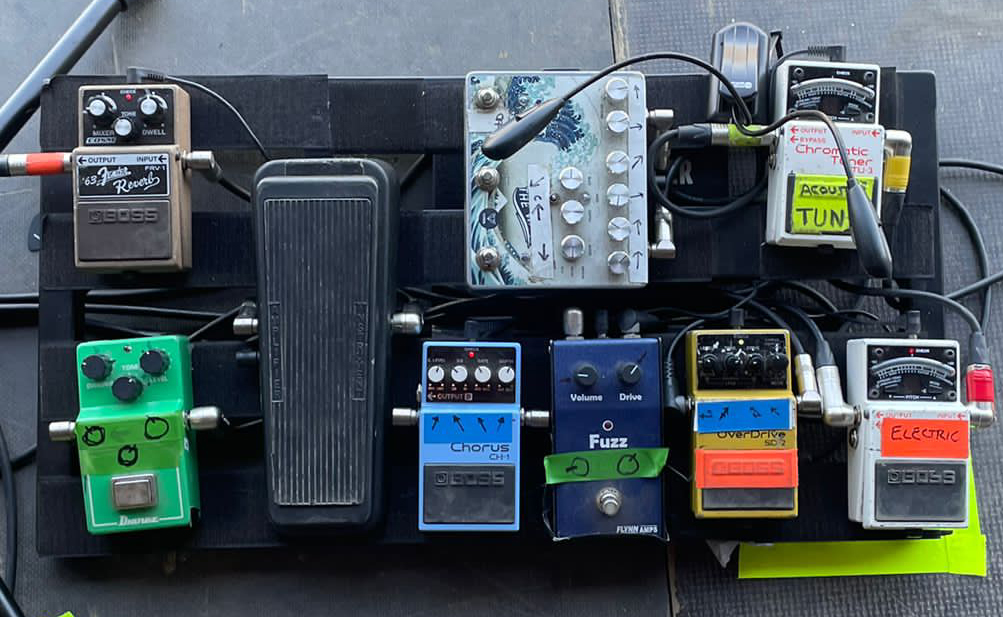
"William Reid from The Jesus and Mary Chain uses a GE-7 and an OD-3 Overdrive."
Al Robinson
Low-End Love
How do some of the bassists you’ve worked with use their BOSS pedals?
In Oysterband, the bass player Ray “Chopper” Cooper also played cello, and we would run that through an OC-3, which just sounded magnificent—so much low-end!
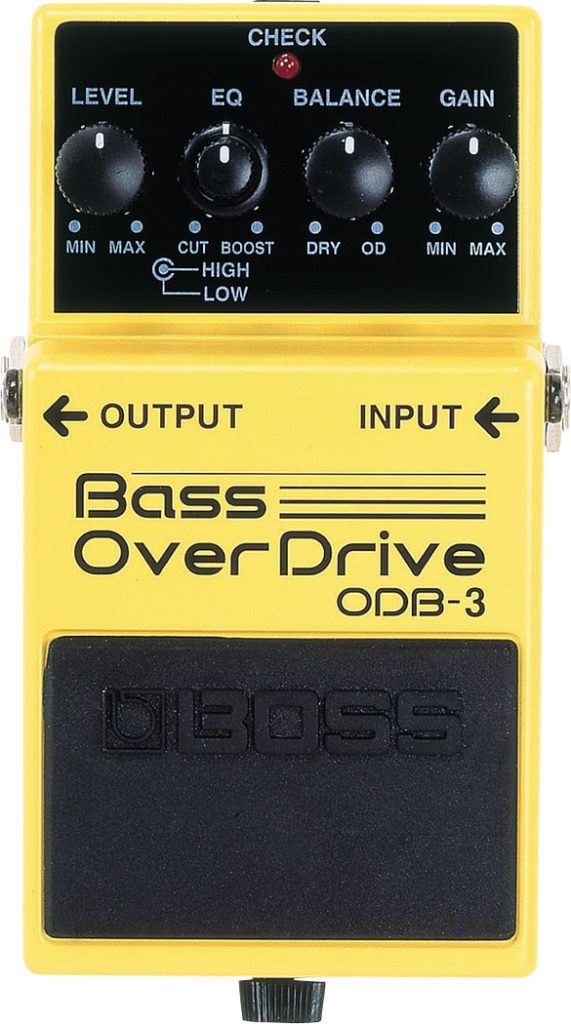
Another great use of BOSS pedals with bass was with Palma Violets. We had a BD-2 Blues Driver on bassist/vocalist Chilli Jesson’s board. Paired with his ’78 Fender Precision Bass and a classic Ampeg amp, it was one of the best bass tones I’ve ever heard.
Speaking of bass overdrive, the ODB-3 Bass Overdrive should not be overlooked. Charlotte Cooper from The Subways, Jeff Hateley from Wolfsbane, and Simon Gallup from The Cure all use the ODB-3 to excellent effect.
"ODB-3 Bass Overdrive should not be overlooked."
Al Robinson
Tech Favorites
Speaking as a guitar tech, what do you like most about BOSS pedals?
When you look down and see a BOSS pedal on a board, you know exactly what you’re going to get. You know the build quality means it’s practically indestructible and that it doesn’t matter if you’re lost in the moment and stomp too hard on it. They always sound great, and they’re ultra-reliable. They’re the industry standard.
They’re also affordable for beginners, which makes them a great way to introduce yourself to the possibilities and complexities of building your own tone. As a tech, I know that should I need to replace or add a pedal, no matter where I am in the world, the nearest guitar shop is almost certain to have the one I want.
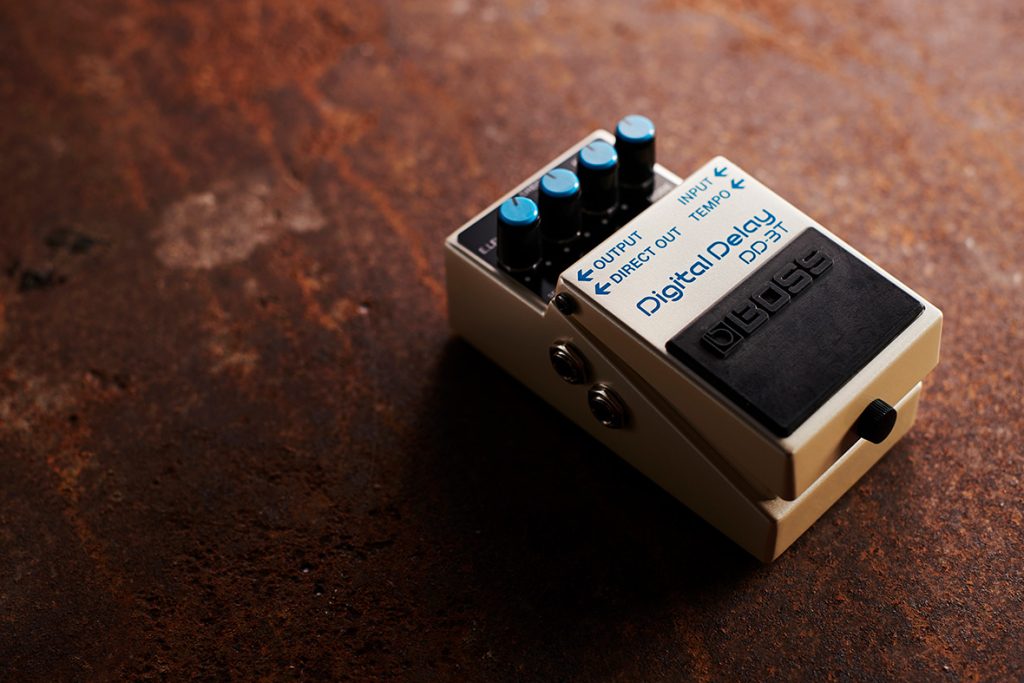
"BOSS pedals always sound great, and they're ultra-reliable. They're the industry standard."
Al Robinson
Which BOSS pedals do you own?
All my gear seems to have migrated to my eldest kid’s bedroom over the last few years! He loves the RC-3 Loop Station. In fact, he’s used it to much greater effect than I ever did!
When I was a teenager in the 1980s, it was all about the OD-1 Overdrive and BF-2 Flanger and trying to sound like Randy Rhoads. Then I discovered the DD-3 Digital Delay and Hawkwind.
What’s your favorite BOSS pedal of all time?
It could well be the DD-3. The possibilities blew my mind. It suddenly made me feel as if I knew what I was doing. I lost hours and hours fooling around with it.
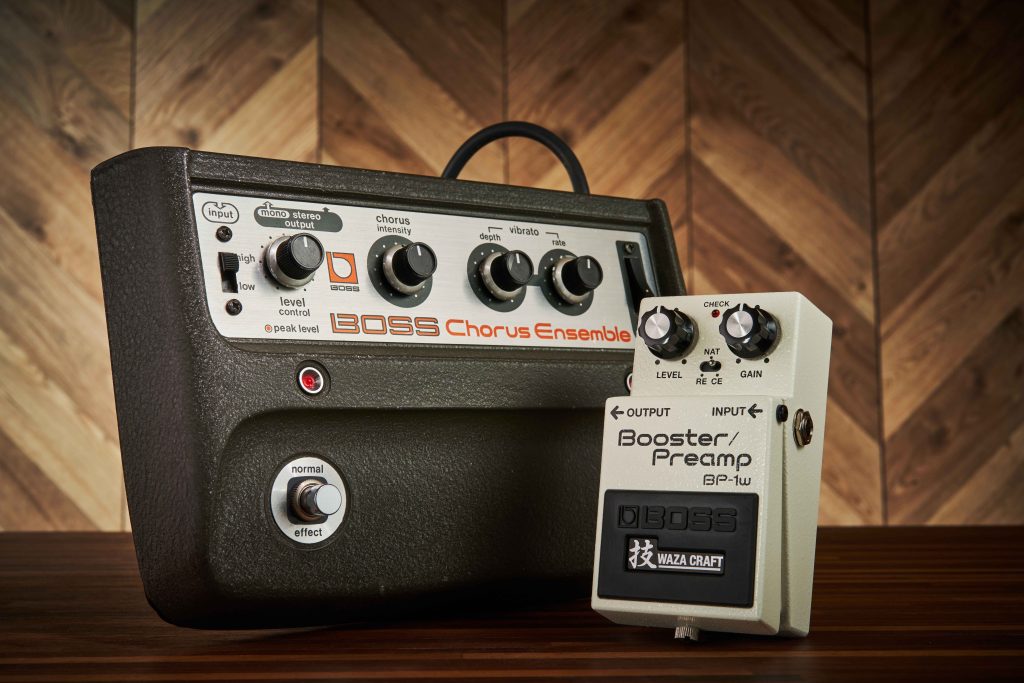
Timeless Tones
Would you like to see any BOSS classics return?
I think the CE-1 Chorus Ensemble and the DB-5 Driver would both be welcome returns. They have such a cool retro look, and I think they’d be a hit. Reeves has a couple of both, and I’ve played around with them in his studio. They’re lovely pieces of kit (and almost as old as me!). I also like the TW-1 T Wah/Touch Wah, but that’s pretty niche.
What are some of your favorite BOSS pedal moments of all time on record?
There’s the TW-1 on “What I Am” by Edie Brickell & New Bohemians. I also love Robert Smith’s sound on The Cure’s “A Forest” and Alex Lifeson’s use of the CE-1 on “Spirit of Radio.” And what about Billy Duffy on The Cult’s “She Sells Sanctuary”? I think that’s a DM-2 Delay, plus some other BOSS pedals.
Which three pedals would you pick for your Desert Island BOSS pedalboard and why?
Other than a TU-3? Probably, I’d go back to my youth and have an OD-1, BF-2, and DD-3 and spend all my time writing tributes to Hawkwind.
Do you have any pedalboard tips?
Just respect your chain and make sure you have them in the right order, or you’re setting yourself up for a world of pain. There have been a bunch of times I’ve started working with a young band that’s built their boards in the order they’ve bought the effects and have really struggled to get them to sound nice. Respect the chain!
What is your view on the current state of the effects pedal market?
Ah, man, it’s beautiful. There’s so much weirdness out there. The only limit is your imagination—and your pocket!
